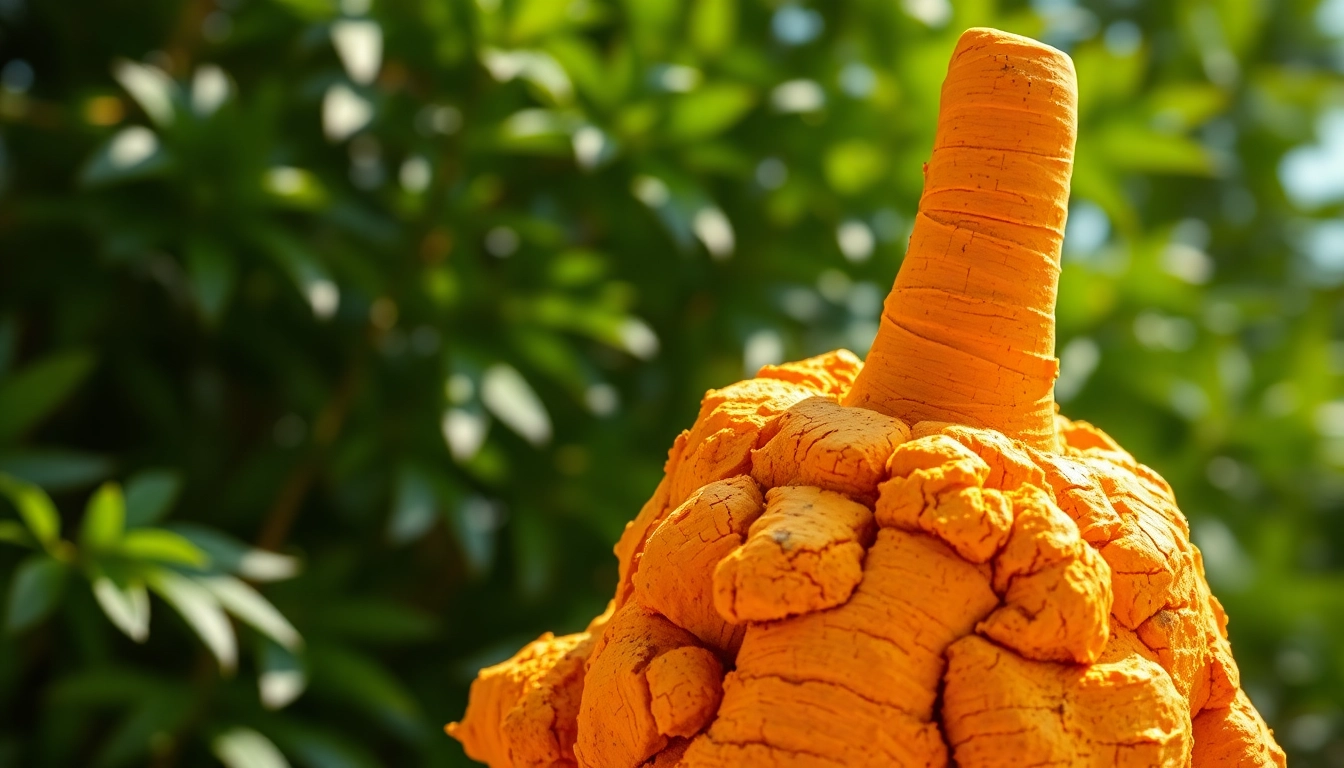Understanding Turmeric Root: Origins and Characteristics
What is Turmeric Root?
Turmeric root, scientifically known as Curcuma longa, is a rhizome that belongs to the ginger family and is native to Southeast Asia. Often referred to as “Indian saffron” due to its vibrant yellow-orange hue, turmeric has been a staple in cooking and traditional medicine for thousands of years. This remarkable root is revered not only for its culinary applications but also for its numerous health benefits, primarily attributed to a compound called curcumin. Turmeric Root is celebrated for its versatility and its role as a potent ingredient in various cultural dishes, especially in Indian and Middle Eastern cuisines.
Cultivation and Harvesting Processes
The cultivation of turmeric involves several critical steps. Growing turmeric begins with selecting the right variety and ensuring appropriate soil conditions. Generally, turmeric thrives in warm, humid climates, requiring plenty of rainfall or irrigation. The rhizomes are planted in well-drained, nutrient-rich soil and are propagated through sections of the root. They typically take several months to mature, usually around 8 to 10 months, at which point the leaves begin to wilt and turn yellow, signaling the time for harvest.
Harvesting is a labor-intensive process. It involves digging up the rhizomes carefully to avoid damage, followed by thorough washing to remove soil and impurities. After washing, the roots can either be consumed fresh, dried, or ground into a powder, depending on their intended use. The drying process is crucial, as it enhances the shelf-life and preserves the beneficial properties of turmeric. Once dried, turmeric can be stored for long periods without losing its flavor or potency.
Nutritional Profile and Potent Compounds
Turmeric root boasts a rich nutritional profile, making it a valuable addition to any diet. It contains a variety of vitamins and minerals, including vitamin C, vitamin B6, potassium, and manganese. However, the most noteworthy aspect of turmeric is its high concentration of curcumin, which accounts for its vibrant color and therapeutic properties. Curcumin is known for its anti-inflammatory, antioxidant, and anticancer effects.
Moreover, turmeric contains various other bioactive compounds such as turmerone and ar-turmerone, which also contribute to its health benefits. Together, these compounds work synergistically to provide an array of health-promoting effects, making turmeric root not just a spice, but a powerful health ally.
Health Benefits of Turmeric Root
Anti-inflammatory Properties
One of the most well-documented benefits of turmeric root is its anti-inflammatory properties. Chronic inflammation is a contributing factor in many diseases, including arthritis, heart disease, and inflammatory bowel conditions. Curcumin has been shown to inhibit various molecules that play a role in inflammation, such as cytokines and enzymes. This makes turmeric an excellent natural remedy for managing inflammation-related health issues.
Research indicates that curcumin can be as effective as some anti-inflammatory drugs, without the side effects that often accompany pharmaceutical medications. A regular intake of turmeric can help maintain a balanced inflammatory response in the body, promoting overall health and well-being.
Antioxidant Benefits and Disease Prevention
Another vital benefit of turmeric root is its potent antioxidant properties. Antioxidants are essential for neutralizing free radicals—unstable molecules that can cause cellular damage and contribute to various diseases, including cancer and neurodegenerative disorders. Curcumin’s chemical structure enables it to effectively combat oxidative stress, providing protective benefits at the cellular level.
Studies have shown that turmeric can enhance the body’s antioxidant defenses, potentially lowering the risk of chronic diseases. Its role in preventing oxidative damage underscores the significance of including turmeric in our daily diets, as it not only supports overall health but also helps reduce the risk of various diseases.
Effects on Digestion and Immunity
Turmeric has long been recognized as beneficial for digestive health. It stimulates the production of bile, which aids in digestion and helps to reduce symptoms of bloating and discomfort. Additionally, its anti-inflammatory properties can soothe the gut, making turmeric a go-to remedy for individuals suffering from digestive disorders such as irritable bowel syndrome (IBS).
Furthermore, turmeric’s immune-boosting properties make it a valuable addition to one’s diet. By enhancing the body’s immune response, turmeric helps to ward off infections and supports overall health. Regular consumption may improve the body’s resilience against pathogens, making it an essential supplement during cold and flu seasons.
Culinary Uses of Turmeric Root
Incorporating Turmeric Root into Everyday Dishes
Turmeric root can be easily incorporated into a wide variety of dishes, adding not only flavor but also color and health benefits. In Indian cuisine, it is a fundamental ingredient in curries, where it contributes to the dish’s signature warmth and yellow color. Freshly grated turmeric can be used in smoothies, soups, and salads, while powdered turmeric is often included in spice blends.
In addition to traditional dishes, turmeric can be creatively integrated into modern recipes. For example, it can be infused into beverages such as lattes or teas, providing a warm, spicy flavor profile while delivering health benefits. Pairing turmeric with black pepper enhances curcumin’s bioavailability, allowing the body to absorb it more effectively.
Recipes Featuring Fresh Turmeric Root
Here are a few simple and delicious recipes to get you started on incorporating fresh turmeric root into your meals:
- Turmeric Ginger Tea: Boil water with sliced fresh turmeric and ginger. Sweeten with honey and enjoy a soothing cup.
- Golden Milk: Heat milk (or a milk substitute) and stir in turmeric, black pepper, and honey for a warm, comforting drink.
- Turmeric Rice: Add grated turmeric to your rice cooking water for a flavorful and vibrant side dish.
- Turmeric-Scented Roasted Vegetables: Toss root vegetables with olive oil, salt, pepper, and freshly grated turmeric before roasting.
Pairing Turmeric with Other Ingredients
To maximize the health benefits and enhance the flavor of turmeric, pairing it with other ingredients can be advantageous. For instance, combining turmeric with black pepper significantly increases curcumin absorption thanks to piperine, an active compound in black pepper. Similarly, turmeric pairs well with healthy fats, such as coconut oil or olive oil, which can also aid absorption.
Fruits such as mango and pineapple, known for their digestive benefits, complement turmeric in smoothies and salads, while spices like cumin and coriander can accentuate its flavor in cooking. Experimenting with various ingredient pairings can lead to delightful culinary creations that are both tasteful and nutritious.
Choosing Quality Turmeric Root: What to Look For
Fresh vs. Dried Turmeric Root
When selecting turmeric root, it’s essential to consider whether to choose fresh or dried forms. Fresh turmeric root is often more potent and contains higher levels of curcumin than its dried counterpart. It also has a distinct flavor profile that can enhance dishes in unique ways. However, dried turmeric root is more convenient and has a longer shelf life, making it a practical choice for daily cooking.
When buying dried turmeric, opt for high-quality organic sources to ensure the absence of pesticides or additives. For fresh turmeric, look for roots that are firm to the touch, have a vibrant color, and are free from blemishes or soft spots.
Organic Certification and Sourcing
Choosing organic turmeric root is crucial for maximizing health benefits while minimizing potential exposure to harmful chemicals. Organic certification ensures that the turmeric is grown without synthetic fertilizers, pesticides, or genetically modified organisms (GMOs). Additionally, sourcing turmeric from reputable growers or brands that prioritize sustainable practices can enhance quality.
Researching the source of your turmeric can provide insights into its cultivation and processing methods, ensuring you receive a product that aligns with your health and environmental values.
Storage and Preservation Tips
Proper storage of turmeric root is vital for maintaining its flavor and potency. Fresh turmeric should be stored in the refrigerator, preferably wrapped in paper towels or placed in a paper bag, to absorb excess moisture. It can last for several weeks if stored correctly.
Dried turmeric should be kept in an airtight container, away from light and heat, to preserve its freshness and flavor. It is best used within a year to ensure optimal quality. If you notice a loss of color or a musty smell, it may be time to replace your dried turmeric.
Potential Side Effects and Considerations
Common Misconceptions About Turmeric Root
Despite its numerous health benefits, there are misconceptions surrounding turmeric root that deserve clarification. Some people may believe that turmeric is entirely safe with no side effects; however, excessive consumption can lead to gastrointestinal upset and may interfere with blood-thinning medications due to its blood-thinning properties.
It’s also important to note that some individuals may be allergic to turmeric or experience sensitivities. Consulting with a healthcare professional before adding large amounts of turmeric to your diet is advisable, especially for those with existing health conditions.
Dosage Recommendations for Optimal Benefits
The optimal dosage of turmeric can vary depending on the individual and specific health goals. For general health maintenance, a daily intake of 1 to 3 grams of turmeric powder or 10 to 30 milligrams of curcumin is often recommended. For therapeutic purposes, such doses may be increased, especially under medical supervision.
Incorporating turmeric into your diet in various forms—whether fresh, powdered, or as a supplement—can provide health benefits without necessitating excessive amounts. It’s important to balance turmeric intake with a diet rich in whole foods and adequate hydration.
Who Should Avoid Turmeric Root?
Certain individuals may need to avoid turmeric or limit its intake. Pregnant women are often advised against consuming high doses of turmeric, as it may stimulate the uterus or pose other risks. Those with gallbladder issues or bile duct obstruction should also approach turmeric cautiously, as it can stimulate bile flow and exacerbate these conditions.
Individuals on blood-thinning medications, such as warfarin or aspirin, should consult their healthcare providers to mitigate potential interactions. Overall, while turmeric offers considerable health benefits, personal medical history should guide its use.



